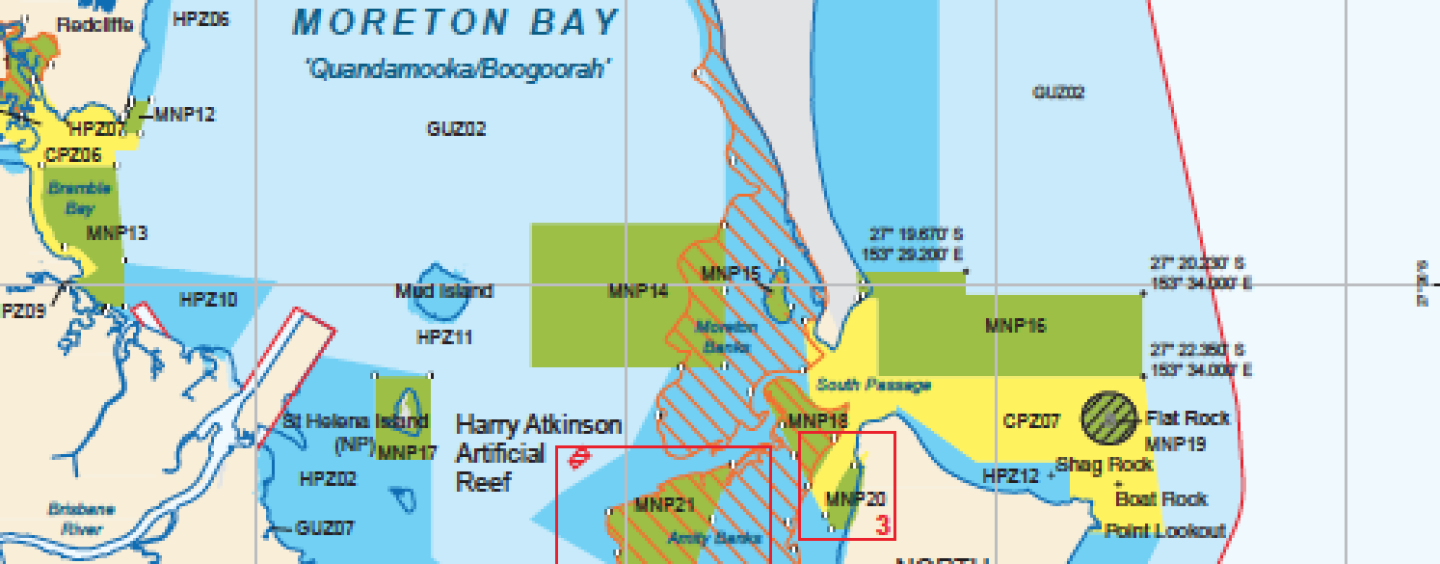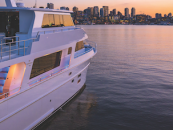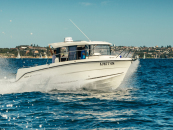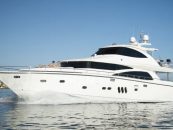If you are boating or fishing in the Gold Coast and Brisbane areas, you need to be aware of the size and possession limits of your catch, and the boating rules and regulations. However, you also need to know if you are inside the boundary of the Moreton Bay Marine Park (better to presume that you are!), as this area has its own special rules and regulations that must also be followed.
The Moreton Bay Marine Park encompasses Moreton Bay, Jumpinpin, the Southport Broadwater, some rivers and tributaries, and several nautical miles offshore from Moreton Island, Bribie Island, and North and South Stradbroke Islands.
Marine Park Zones
The Moreton Bay Marine Park has four zone types: 1. General use zone (light blue); 2. Habitat protection zone (dark blue); 3. Conservation park zone (yellow); 4. Marine national park zone (green). Each zone has its own rules with regard to fishing and boating activities.
GREEN ZONE – Marine National Park. While anyone can enter and undertake activities such as boating, snorkelling and sailing, no fishing, crabbing, or bait gathering is permitted in the green marine national park zones. Like a national park in the water, these areas are ‘NO-TAKE areas’ of high conservation value. Green zones provide the greatest level of protection in the marine park. All forms of take (fishing, collecting or extracting) are prohibited.
All fishing equipment including rods, crab pots, cast nets, and yabby pumps must be stowed or secured; otherwise you will be fined. “Stowed” means being not readily useable for fishing. For example, bait must be removed from hooks, fishing lures must be removed from lines, bait must be removed from crab pots, and you cannot have a cast net tied around your wrist.
YELLOW ZONE – Conservation Park. These zones are areas of high conservation value for habitat and wildlife that also allow for limited recreational and commercial uses such as fishing and crabbing.
A maximum of two lines and a total of two hooks per angler is permitted. A fishing lure with up to 3 trebles is considered to be a single hook, as are squid jigs, bait jigs (with up to 6 hooks of size 1-12), and gangs with up to 6 adjoined hooks (as long as the shank passes through the eye; hooks joined by swivels are considered individual hooks).
The yellow conservation park zone rules specify that only a maximum of four crab pots per person is permitted.
DARK BLUE ZONE – Habitat Protection. The dark blue habitat protection zones protect sensitive habitats by keeping them generally free from potentially damaging activities. No trawling is allowed in these zones.
LIGHT BLUE ZONE – General Use. The light blue general use zones provide for conservation while allowing a wide range of activities to occur including trawling (with an appropriate commercial fishing permit).
BOXED TEXT HERE (IF POSSIBLE): The Queensland recreational fishing rules and regulations on crab pots, specifying that no more than four crab pots per person may be used, and that there must not be more than four pots on a boat per person when on the water, also apply in both dark blue and light blue zones.
Spearfishing
Although limited spearfishing is permitted in the general use (light blue), habitat protection (dark blue), and conservation (yellow) park zones, there are specific areas within these zones where spearfishing is prohibited. For example, spearfishing is prohibited everywhere south of the Logan River, including Jumpinpin, the Southport Broadwater, and inside the Gold Coast Seaway. In any case, it is necessary to seek government information on spearfishing. Fisheries Queensland will be able to provide details on specific areas. (Contact 13 25 23 or visit https://www.daf.qld.gov.au/fisheries/recreational/rules-regulations/closed-waters-tidal-waters.)
Go-Slow Zones
Boaters must also be aware that there are several “Go-Slow” zones present in the marine park, either to protect dugongs and turtles from boat strike, or to protect the natural integrity of the location.
Most of these go-slow zones generally follow either the 5m or 2m depth contours. In these areas, all vessels must travel off-the-plane or in displacement mode.
Motorised water sports are prohibited within these zones. Examples of motorised water sports include:
- driving a vessel (including personal watercraft) other than in a straight line; for example driving in circles, weaving, and surfing down or jumping over waves, swell or wash
- towing a person (waterskiing, parasailing or wakeboarding)
- personal watercraft not taking the most reasonable direct route between two places.
There are also some “Go-Slow” zones for vessels over 8 metres, particularly near Russell Island and Macleay Island. In these zones, vessels over 8 metres must travel at 10 knots or less.
Important Reminders
For the protection of coral, no anchoring is permitted around Flat Rock off Point Lookout on North Stradbroke Island, and around Flinders Reef off Cape Moreton on Moreton Island.
If you intend to collect fish and other organisms for your home aquarium, you should consult Schedule 3 of the Marine Parks (Moreton Bay) Zoning Plan 2008 (https://www.legislation.qld.gov.au/view/html/inforce/2017-09-01/sl-2008-0343#sch.3). A total of five specimens and only two of each species can be collected in all zones except marine national park (green) zones where all collecting is prohibited. This is defined as limited collecting.
Protected species such as seahorses, pipefish, and seadragons are prohibited from being collected (live or dead). The collection of hard and soft corals, sea fans, and anemones is also prohibited without a permit. All limited collecting must be undertaken by hand or using a hand-held implement that is not motorized, or pneumatically or hydraulically driven, and a permit is required to collect any more than the prescribed numbers.
Please note that size and possession limits specified in the Queensland recreational fishing rules and regulations also apply, even if the organisms are in your home aquarium. For example, you cannot posses an undersized male mud crab in your home aquarium, nor can you posses more than 5 of the same species of wrasse at any one time.
**Please be aware that it is quite impractical and financially unviable to sign every part of every zone within the marine park. It is, therefore, the skipper’s responsibility to be aware of the vessel’s current location and to be able to determine if the vessel is inside a particular zone boundary. Ignorance of the rules, or being unaware of your current location, is not a valid excuse to save yourself from being fined by Moreton Bay Marine Parks, the Queensland Boating and Fisheries Patrol, or the Queensland Water Police.
The Department of National Parks, Sport and Racing (NPSR) is the state government department responsible for setting the rules and regulations for the Moreton Bay Marine Park (https://www.npsr.qld.gov.au/parks/moreton-bay/). The Queensland Parks and Wildlife Service (QPWS) is responsible for the day-to-day management of the park.
The Moreton Bay Marine Park User Guide outlines the rules and regulations and is downloadable here: https://www.npsr.qld.gov.au/parks/moreton-bay/zoning/pdf/marine-park-user-guide.pdf.
Compiled by Nic Welch






























